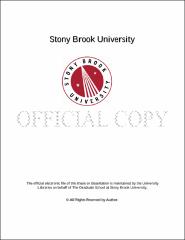| dc.identifier.uri | http://hdl.handle.net/11401/77566 | |
| dc.description.sponsorship | This work is sponsored by the Stony Brook University Graduate School in compliance with the requirements for completion of degree. | en_US |
| dc.format | Monograph | |
| dc.format.medium | Electronic Resource | en_US |
| dc.language.iso | en_US | |
| dc.publisher | The Graduate School, Stony Brook University: Stony Brook, NY. | |
| dc.type | Thesis | |
| dcterms.abstract | This thesis investigates the growing trend in late 20th- and early 21st-century post-apocalyptic fiction to feature cannibalism. I argue that these narratives reimagine the cannibal to reflect today’s global worldview. By comparing contemporary cannibal narratives such as David Mitchell’s Cloud Atlas and the Wachowskis’ film series The Matrix to H. G. Wells’s classic novel The Time Machine, I show that today’s cannibal narratives radically destabilize the binary oppositions of (usually Western) civilized humanity and its savage, cannibal-animal others that traditional cannibal narratives tend to underwrite. The traditional cannibal figure has been an essential element in not only the construction of the human but also the geographical and chronological mapping of the world. I argue that today’s cannibal narratives represent the collapse of distinctions between self and other, chronological distinctions of past, present, and future (that lead to a teleological historical sense), and geographical distinctions of here and there (that underpin nationalism). They accomplish this in their formal innovation—using self-cannibalizing forms evocative of Nietzsche’s eternal recurrence and the oroborus (a serpent consuming its own tail)—and thematically by reimagining the cannibal as an often unwitting self-cannibal that is typified by a new sense of intimacy. I argue that the act of self-cannibalization is a symptom of posthumanism after the end of the world. Following Timothy Morton’s analysis of hyperobjects in Hyperobjects: Philosophy and Ecology after the End of the World, I claim that the figure of the cannibal appears in contemporary post-apocalyptic narratives not as a warning of some impending catastrophe, but as a traumatic repetition of the catastrophe that has already occurred. Hyperobjects such as global warming, globalization, and a new awareness of being enmeshed in a global totality has brought about the end of the world as it has traditionally been conceived. I conclude that Cloud Atlas and other contemporary post-apocalyptic fiction deploy the figure of the posthuman, self-cannibal as a means to write the world after the end of the world. | |
| dcterms.abstract | This thesis investigates the growing trend in late 20th- and early 21st-century post-apocalyptic fiction to feature cannibalism. I argue that these narratives reimagine the cannibal to reflect today’s global worldview. By comparing contemporary cannibal narratives such as David Mitchell’s Cloud Atlas and the Wachowskis’ film series The Matrix to H. G. Wells’s classic novel The Time Machine, I show that today’s cannibal narratives radically destabilize the binary oppositions of (usually Western) civilized humanity and its savage, cannibal-animal others that traditional cannibal narratives tend to underwrite. The traditional cannibal figure has been an essential element in not only the construction of the human but also the geographical and chronological mapping of the world. I argue that today’s cannibal narratives represent the collapse of distinctions between self and other, chronological distinctions of past, present, and future (that lead to a teleological historical sense), and geographical distinctions of here and there (that underpin nationalism). They accomplish this in their formal innovation—using self-cannibalizing forms evocative of Nietzsche’s eternal recurrence and the oroborus (a serpent consuming its own tail)—and thematically by reimagining the cannibal as an often unwitting self-cannibal that is typified by a new sense of intimacy. I argue that the act of self-cannibalization is a symptom of posthumanism after the end of the world. Following Timothy Morton’s analysis of hyperobjects in Hyperobjects: Philosophy and Ecology after the End of the World, I claim that the figure of the cannibal appears in contemporary post-apocalyptic narratives not as a warning of some impending catastrophe, but as a traumatic repetition of the catastrophe that has already occurred. Hyperobjects such as global warming, globalization, and a new awareness of being enmeshed in a global totality has brought about the end of the world as it has traditionally been conceived. I conclude that Cloud Atlas and other contemporary post-apocalyptic fiction deploy the figure of the posthuman, self-cannibal as a means to write the world after the end of the world. | |
| dcterms.available | 2017-09-20T16:52:55Z | |
| dcterms.contributor | Scheckel, Susan. | en_US |
| dcterms.contributor | Johnston, Justin O | en_US |
| dcterms.creator | Kampff, Joseph Ronald | |
| dcterms.dateAccepted | 2017-09-20T16:52:55Z | |
| dcterms.dateSubmitted | 2017-09-20T16:52:55Z | |
| dcterms.description | Department of English. | en_US |
| dcterms.extent | 48 pg. | en_US |
| dcterms.format | Monograph | |
| dcterms.format | Application/PDF | en_US |
| dcterms.identifier | http://hdl.handle.net/11401/77566 | |
| dcterms.issued | 2015-12-01 | |
| dcterms.language | en_US | |
| dcterms.provenance | Made available in DSpace on 2017-09-20T16:52:55Z (GMT). No. of bitstreams: 1
Kampff_grad.sunysb_0771M_12328.pdf: 2248955 bytes, checksum: 7101c4467fee12dd6865dd716e57d439 (MD5)
Previous issue date: 1 | en |
| dcterms.publisher | The Graduate School, Stony Brook University: Stony Brook, NY. | |
| dcterms.subject | Cannibalism, Cloud Atlas, David Mitchell, Hyperobjects, Post-apocalyptic, The Matrix | |
| dcterms.subject | Literature | |
| dcterms.title | A World Consuming Itself: Posthuman Cannibals After the End of the World | |
| dcterms.type | Thesis | |

